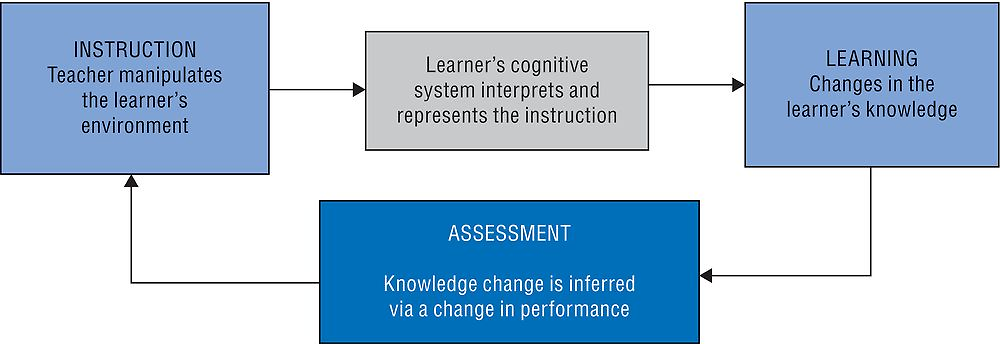
3C - Framework for Learning and Teaching
A 3C - Toolbox for Effective Teachers must have Cognitive, Constructive and Cooperative components
Cognitive component for effective instruction and learning strategies.
Constructive component to help students engage in knowledge construction.
Cooperative component to support students' learning process.

Using 3C Tools for Choosing How to Teach and Learn makes a difference both for you and your students.
The Cognitive approach combined with the Constructive and Cooperative practices enable effective teaching and meaningful learning - with Common Core or any other curriculum.
The 3C Framework
| The holistic view of learning considers learning to be an essential part of our everyday lives in a society, instead of being a function that only happens in the classroom. |
| The holistic view of teaching extends instruction well beyond providing information and simply measuring retention, to supporting students' metacognition. |
The important difference lies in considering didactics, pedagogy and/or andragogy, and subject matter expertise being professionally combined to delivering the curriculum, in order to create a learning environment that is conducive for deep learning.
Deep learning is defined as a complete way of learning something that means you fully understand it and will not forget it.
The cognitive approach combined with constructive and cooperativepractices enable effective teaching and meaningful learning - with any approach or curriculum, whether in preK-12, higher education or at workplace.
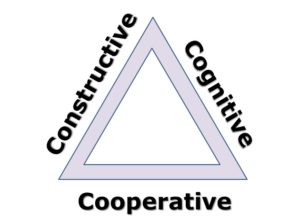 | Cooperation is the foundation for successful (online) learning - with cooperative practivess we can support students’ learning process and help them engage in it. Constructive design focuses on supporting students' learning process - we want to make learning meaningful and increase students' motivation to learn [1] Cognitive approach to teaching and learning - we want to equip students with metacognitive tools to support their individual learning process. |
3C framework also emphasizes using students' self-assessment in order to build feedback loops that support deeper learning. The underlying principle is to empower students to become independent life-long learners.
Here is a 2-page pdf about 3C framework.
While learning as a concept covers both the educational process at school and the way humans absorb information and cultural practices through their everyday interactions, it is important to acknowledge the differences between formal and informal learning.
Formal learning happes within educational systems built for schools, colleges, universities, workplaces, etc., and is usually assessed and evaluated for credentialing. Informal learning is what we do for fun, therefore it often remains uncredited. However, to better support and assess students' learning process, we should find ways to credit informal learning. This is one of the premises of competency-based education.
To focus the 3C framework, and emphasize learning over teaching, I am using Illeris’ [2]definition: “an external interaction process between the learner and his or her social, cultural or material environment, and an internal psychological process of acquisition and elaboration”.
For reasons of maturity and existing knowledge, instructional support for learning IS different in higher education from preK-12. The IDEAL learning has been built for faculty and corporate trainers, and the Effective Learning was made to help preK-12 teachers.
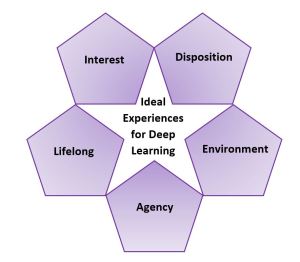 |  |
Click HERE for more information about IDEAL learning at NinasNotes.fi
Click HERE for more information about Effective learning
[1] Martin, A. J., & Marsh, H. W. (2006). Academic resilience and its psychological and educational correlates: a construct validity approach. Psychology in the Schools, 43, 267–282.
[2] Illeris, K. (2003). Toward acontemporary and comprehensive theory of learning. International Journal of Lifelong Education, 22(4), 396-406.doi:10.1080/0260137032000094814. (p. 298)
The 3C Framework for
Effective Learning
Learning and teaching are two different phenomena occurring in the classroom,. Therefore just improving teaching doesn't always yield great learning results. Teachins is just one factor in learning success.
See the star in the picture below? That's where effective learning happens!
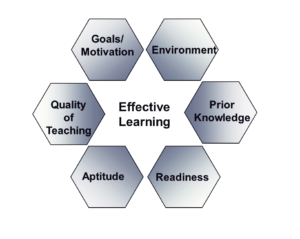
The change in how we understand learning and knowledge has been widely recognized by researchers, and today we refer to a knowledgeable person as one who is aware of knowledge, knows ways to find information and is able to construct knowledge from information (critical thinking, problem solving). Simply memorizing lots of disconnected facts doesn't create strong academic competence, because understanding concepts and connections is necessary in today's world.
Student achievement depends on their engagement and interactions with the learning environment and the content to be learned.
Students' motivation to engage in learning is intrinsic or extrinsic. Classroom participation and real engagement over strategic or ritual compliance are important variables in student learning (here is an interesting infographic about engagement levels). In addition to interest in the subject, engagement also depends on students' aptitude and readiness to learn. To achieve excellent learning results we need to know the science behind the teaching and learning, and have a good understanding about how learning happens to support deeper learning in the classroom.
The 3C framework can help you achieve this!
The 3C framework helps teachers to create the environment, structure and feedback systems needed for supporting students' authentic and independent learning. The framework can be adapted to any curriculum, and it can be used while teaching any subject. Basically the framework contains rules for good quality 21st century teaching and learning!
3Cs for Confident, Curious and Capable Learners
Here is another 3Cs to think about: as teachers we should try our best to ensure that graduating students are confident, curious and capable learners, who will continue to learn on their own. These are the outcomes for using the model explained in the Choosing How to Teach - book.
| 1. | Use non-punitive assessment that emphasizes the value of learning from making mistakes and reconstructing one's own thinking. |
| 2. | Make learning meaningful for students by embedding choices to pique students cognitive interest and curiosity. |
| 3. | Lead students to understand the value of collaborative meaning-making by modeling it in the classroom. |
The confidence and the positive academic self-concept grow from engaging in the learning process and refining one's own thinking. It is awesome to hear students to explain how they understood the misconceptions they had before! Using constructive practices in the classroom helps students to reflect their own thinking and learning.
Why doesn't teaching necessarily mean learning is happening?
Learning and teaching are two separate processes.
They are not the two sides of the same coin! They are two different processes that are often put into the same frame of reference (education) and sometimes even happen in the same physical space (classroom). However, learning happens all the time without teaching. In formal education settings we just wish to have more control over students' learning process.
Learning can be defined as the processes of acquisition and elaboration [1], and what is referred to teaching often is just delivery of information (a monologue, for example lectures, either in class or online), and measuring memorized pieces of that information (tests, exams). Supporting the dual processes of acquisition and elaboration in classroom is very important! Teaching becomes learning facilitation when the teacher and the student engage in a dialogue.
Students are led into the learning process and given freedom to choose (within pedagogically appropriate boundaries) how to construct their own knowledge and which learning activities and strategies to use in order to reach the mutually discussed learning goals. Ideally, students are also allowed to choose the assessment methods most suitable for their needs, but the teacher should lead the students utilize wide selection of assessments.
In such learning environment students' learning is effective and authentic, building on higher level thinking skills and linking new information into already existing structures of personal knowledge and understanding. This is what deep learning looks like: constructing your cognitive capacity by cooperating with your teachers and other students.
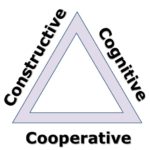
References:
[1] Illeris, K. (2003). Toward a contemporary and comprehensive theory of learning. International Journal of Lifelong Education, 22(4), 396-406. doi:10.1080/0260137032000094814
[2] Niemiec, C. P., & Ryan, R. M. (2009). Autonomy, competence, and relatedness in the classroom: Applying self-determination theory to educational practice. School Field, 7(2), 133-144.
3C Learning and Teaching
The focus in 3C learning and teahcing is supporting students' individual learning processes, rather than emphasizing the importance of teaching and information delivery.
While there is much research about learning and teaching, we still don't fully understand the teaching-learning process due to its complexity, but the cycle below is generally accepted as the representation of this two-fold process:
(Guerriero, 2017, p.101)[1] |
Please note the word "inferred" in the darker blue assessment box. Measuring knowledge change is hard. Considering the whole teaching-learning interaction cycle and how differently students may be interpreting the instruction, it seems obvious that learner-centered approach is needed for supporting students. Being exposed to information delivery in the form or a lecture or video is just the beginning of the learning process!
Deeper, permanent learning happens after the information is received. Students must elaborate on the acquired information and situate the new information into their existing knowledge structure. Sometimes this is hard, because we all have misconceptions about different things. But learning process is still the same - changes in our knowledge.
We need to know how learning happens, so that we can enhance it in the classrooms. In other words, rather than assuming that it is a teacher's job to impart wisdom to students who will somehow magically absorb it, the focus is in the teacher's ability to guide the students into building a knowledge base of their own. One part of the 21st century learning and teaching is asking non-googlable questions and emphasizing applications of learning over reproducing given answers. Students need to learn HOW to think instead of being taught WHAT to think. There is more information (and misinformation) available than ever before in the history of humankind and students need to be prepared to find the important information they need. This supports students' own interests and curiosity, too. Working with students' need to know makes learning and teaching much more meaningful.
Meaningful learning is built on interactions between students and teachers, and being contextual and situational, it greatly helps students to be more interested and more successful in their studies. The concept of meaningful learning is not new: already in 1978 researchers empahsized how important it is for students to engage in active learning and purposefully construct their own knowledge and understanding[2]. Meaningfulness of learning content and instructional delivery support students’ motivation and engagement.
Contemporary educational research recognizes the importance of students’ intrinsic motivation and self-concepts as means for improving their academic performance[3]. The first premise for any deep learning to occur is to introduce the new information in a way that makes students interested in acquiring it.
Building on the theories of meaningful learning and learner-centered teaching, the 3C Framework combines the cognitive approach with the constructive and cooperative practices to enable both effective teaching and meaningful learning.
C1 - Cognitive approach makes teaching and learning easy and effective. Viewing learning as a student-centered and dynamic process where learners are active participants, it strives to understand the reasons behind behavioural patterns. Instruction focuses on application and transfer of the learning, supporting and building students' higher order thinking skills. Learning strategies and metacognitive skills are discussed frequently because this helps students to understand how to best support their own learning, and what is needed for becoming successful in learning and life. Teachers provide graphic organizers and models, and discuss the hierarchy of the concepts in the learning material.
C2 - Constructive practice emphasizes the learning process and students’ need to construct their own understanding. Delivered or transmitted knowledge does not have the same emotional and intellectual value. New learning depends on prior understanding and is interpreted in the context of current understanding, not first as isolated information that is later related to existing knowledge. Constructive learning helps students to understand their own learning process and self-regulate and co-regulate their learning in the classroom and beyond. Regular feedback,self-reflection and joint reflection are important! Teachers individualize their practice and help students to connect new learning to their existing personal knowledge. Self-assessments and rubrics are regular practices.
C3 – Cooperative learning is about providing a collaborative learning environment, reflecting the relation nature of learning. Chooisng to use this basic pedagogical structure automatically supports students' learning process. Cooperative learning environment is inclusive, and it is designed to make learning easier and enjoyable. Teaching and learning become meaningful for both teacher and students, because there is no need for the power struggle in the emotionally safe classroom. From students perspective cooperative learning is about behaving responsibly and being accountable for your own learning. The guiding principle for cooperative learning environment is to have learning-centered orientation in planning, activities, and assessment. Students learn from each other and engage in collaborative meaning-making. Every student has their own strengths and areas to grow, and growth mindset is openly discussed in the class.
What can I do to help you in learning and teaching?
You can email me at NotesFromNina@gmail.com
p.s. check also my blogpost about this at Wordpress
[1] Guerriero, S. (2017). Teachers' pedagogical knowledge: What it is and how it functions. In S. Guerriero (Ed.). Pedagogical knowledge and the changing nature of the teaching profession (pp.99-118). OECD Publishing.
[2] Ausubel, D. P., Novak, J. D. & Hanesian, H. 1978. Educational psychology a
cognitive view. 2. painos. New York: Holt, Rinehart and Winston.
[3] Green, J., Liem, G. A. D., Martin, A. J., Colmar, S., Marsh, H. W., & McInerney, D. (2012). Academic motivation, self-concept, engagement, and performance in high school: Key processes from a longitudinal perspective.Journal of adolescence, 35(5), 1111-1122.
and
Veermans, M., & Tapola, A. (2004). Primary school students’ motivational profiles in longitudinal settings. Scandinavian journal of educational research,48(4), 373-395.

